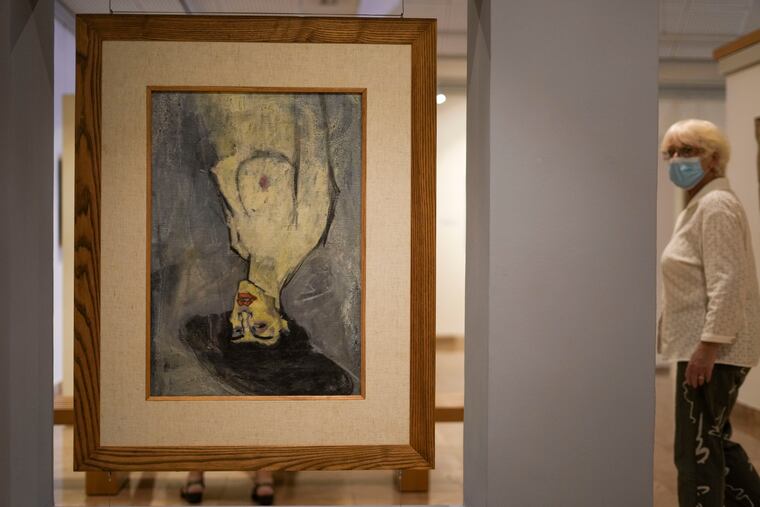Six hidden gems in ‘Modigliani Up Close’ at the Barnes
Six pieces of art from Barnes' Modigliani exhibit, each marked by the artist's signature style and process.

‘Nude with a Hat’/’Maud Abrantès’
This double-sided painting is the first, but by no means the last, canvas that Modigliani used multiple times. Beneath the surface of the two visible paintings are four sketches, including what is possibly a self-portrait beneath Nude with a Hat. Inna Berkowits, an art historian at the Hecht Museum, called the double portrait essentially “a sketchbook on a canvas.” One of the spectral paintings beneath Maud features almond-shaped blue eyes and thin, arching brows.
‘Head’
Modigliani had stopped making sculptures by about 1915, said Barbara Buckley, Barnes’ director of conservation, but that was long enough “to inform his painting.”
» READ MORE: You can now see the hidden art beneath Modigliani’s paintings
“Even if it’s a brief moment that he sculpts, it’s way more impactful in the long run,” she said, “We’ve tried to set up this dialogue between the sculptures and the paintings.”
Technical analysis of the Barnes’ Head also corroborated some anecdotes about the artist. Sculptor Jacob Epstein recalled that Modigliani would set candles on the sculptures — lending his studio the air of a temple. Curator Simonetta Fraquelli confirmed that analysts have found “some wax on top of the sculptures” lending authenticity to the temple stories.
‘Portrait of a Girl’
The Tate, London analyzed this portrait with X-ray technology in 2018 and discovered a nearly completed portrait of Beatrice Hastings, an English writer and one of Modigliani’s lovers, beneath the surface.
“When we saw that x-radiograph for the first time with Nancy [Ireson, deputy director for collections and exhibitions and chief curator at the Barnes] and Simonetta [Fraquelli, independent curator and consulting curator for the Barnes] they instantly said, ‘Oh, I know exactly what that looks like,’ and they referred to a painting in the VAC Foundation in Moscow, which is this portrait of Beatrice Hastings,” said the Tate’s Annette King. “The likeness is remarkable. And that’s the joy of working together because instantly we could recognize that.”
Once the under-portrait was revealed, King said, it became clear that Modigliani used “the neck of Beatrice Hastings to form the side of the nose of the upper portrait and he [used] the skirt as the shoulders.”
′Reclining Nude From the Back’
Barnes purchased this in 1926, from Galerie Barbazanges. It is one of two nudes Modigliani painted from the back and unlike the other nudes on view, Reclining Nude is painted on a white ground. (The others are on a blue-grey ground.)
“With the Barnes nude, the flesh is very thin and transparent and you see a lot of the white ground layer show,” Buckley said.
With a new piece of equipment that the Barnes acquired during the project, curators found “a fairly extensive underdrawing” under Reclining Nude, demonstrating that Modigliani changed the position of the arms slightly, which “makes all the difference in her form as it lies across the canvas,” Buckley added.
′The Little Peasant’
In May 1918, Modigliani left Paris for the south of France. Most of the canvases from this period have similar formats, and the images are “slightly off-center,” said King. They are, she said, “harmoniously” asymmetrical.
“He’s so well organized and he paints and draws exquisitely,” she said . “But I think that the technical research and looking closely at the work is a great foil to the stories of him as a chaotic drunk.”
Modigliani took a white canvas, making a very simple drawing on it. “There’s a little infrared image next to the painting which just shows a very simple oval for the face,” she said. “He’s painting the flesh very carefully. He’s used a paint that is matte, and it holds the brushstrokes very clearly. He’s actually using the direction of the brush to create the three dimensionality of the face. There’s very little color change, but the brushstrokes really form the chin and the crevice under the nose. But just the color the sort of graduation of his cheeks from orange to pink to pale pink is seamless.”
‘Self Portrait’
There are two self-portraits in the exhibition, one from 1915 presenting Modigliani as Pierrot, and one from 1919 of the artist holding a palette in his right hand. One intriguing question answered by the technical analysis of the painting: Are the colors depicted on the palette the same colors used in the painting? Fraquelli says yes.
“Historically, people used to say that he didn’t use many pigments,” she said. The study debunked that belief.
“In fact, he used a great number of pigments, probably more than 25,” Fraquelli added.
“Modigliani Up Close” runs through Jan. 29, 2023 at the Barnes Foundation. For details, visit: https://www.barnesfoundation.org/whats-on/exhibitions/modigliani-up-close